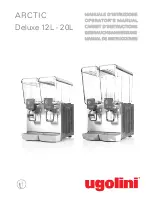
F3D3
Series
Service Manual Refrigeration / Section 4.4.2
Questions? Call Franke Technical Support Group For Your Area. Copyright
2012 Franke, Inc. All rights reserved.
4.4.2 Cold Wall Evaporator Leak Detection
NOTE:
F3D3 & F3D3S Models ONLY -
This procedure for
leak detection should be used when electronic detection or
soap failed to locate a leak in the system HIGH SIDE.
(See
procedure 4.4 & 4.4.1 before using this procedure.)
1)
After trying other leak detection methods, recover any
remaining refrigerant.
2)
Separate the high side from the low side. Use a tubing
cutter to cut the copper lines going into the cabinet walls.
3)
Solder access fittings to both sides of the evaporator
(both lines coming out of the cabinet wall).
4)
Before pressurizing the low side, check for restrictions in
the evaporator tubing by blowing some nitrogen through
the system.
NOTE:
Some oil is likely to come through so
have a rag ready. Clean oil has the consistency and
appearance of water. Thick or discolored oil or other
material may indicate other problems in the system.
5)
Pressurize the low side line to
250 PSIG
[14.7 Bars]
using nitrogen. Check for leaks at newly installed access
fittings and hose connections using soap bubbles. Also
check for leaks where lines go into the cabinet body.
6)
After about 10 minutes, when system pressure is steady,
record the test pressure
. Also record room and cabinet
inside wall temperatures:
Record Pressure & Temps.
Initial
After 24 Hours
Test Pressure:
PSIG/Bar PSIG/Bar
Room Temperature:
°C / °F
°C / °F
Inside Wall Temperature:
°C / °F
°C / °F
7)
Leave the unit pressurized for 24 hours.
8)
Record the pressure and temperatures again at the end
of the test period.
A pressure drop of more than 10
PSIG [.7 Bar] within 24 hours indicates there is a leak
in the evaporator.
9)
IMPORTANT:
If an evaporator leak is clearly indicated,
contact Franke Technical Support for assistance.
[Photo 1]
Separate and cut the high & low
side lines from the (cold wall)
evaporator and solder on access
fittings.
[Photo 2]
Pressurize the low side to 250
PSIG [17.2 Bars] using nitrogen,
check for leaks and pressure
level after 10 minutes & again
after 24 hours.
Rev. 1 11/2012
Tools-Supplies Required:
Tubing cutter
Two access fittings
Torch, solder, etc.
Manifold Refrigeration
Pressure Gauge
Liquid leak-detection soap
Rag or paper towels
NOTE
: Do not use an electronic leak detector to locate
leaks inside the freezer evaporator housing. The foam
insulation used inside the evaporator housing contains
HFCs, which will generate false readings.
IMPORTANT:
Following this procedure and documentation
of test pressures may be required for warranty coverage.





































